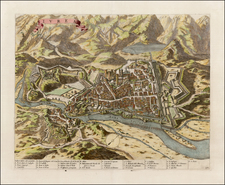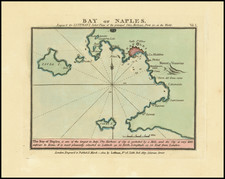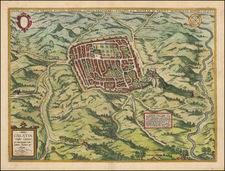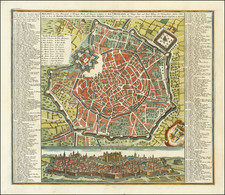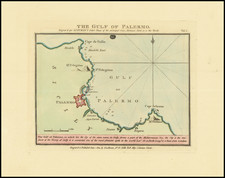The 1862 Plan of Siena and its Environs: A Chronicle of Time
Siena, a jewel in the heart of Tuscany, stands as a testament to the rich tapestry of Italian history. By 1862, its urban structure, reflected in a plan of the city, bore witness to centuries of art, architecture, and politics. This plan, oriented with southwest at the top, not only delineates the urban layout of Siena but also encapsulates the story of its past.
Central to this map is Siena's beating heart: the Piazza del Campo. This fan-shaped plaza has always been the center of public life. Historically, the renowned Palio horse race, which began in the 6th century, took place here, symbolizing the city's distinct contrade (districts).
Adjacent to this is the Piazza del Duomo, dominated by the majestic Siena Cathedral. Built between the 12th and 14th centuries, the Duomo stands as a testament to Siena's golden age, when the city was a major power in Tuscany, rivaling even Florence. The cathedral's intricate Gothic architecture and artworks by renowned artists like Pisano and Donatello speak to the city's rich cultural heritage.
The Piazza di Mercato Vecchio, or the "Old Market Square," once known as the Foro Boario, was the commercial heart of the city. It tells tales of bustling trade, where merchants from distant lands came to peddle their goods, showcasing Siena's significance as a trade hub in medieval Italy.
Beyond the city's heart, the plan showcases the impressive fortifications that once protected Siena. The Porta Camollia, traditionally the northern gate, is tied with stories of Florence's frequent attempts to besiege Siena. The Porta Romana, to the city's south, stands as a sentinel, having witnessed countless travelers enter from Rome. Porta Ovile, Porta S. Viene, Porta Tufi, Porta S. Marco, Porta Laterina, and Porta Fontebranda, each with its own story, further fortified this proud city, ensuring it remained impregnable to foes.
The Cittadella, a military fortress, stood in silent testimony to the numerous wars and skirmishes that dotted Siena's history, ensuring the city's independence was not easily threatened.
But to understand the importance of this 1862 plan, one must trace back Siena's history. Founded by the Etruscans, Siena came under Roman rule in the era of Emperor Augustus. However, its golden age began in the Middle Ages. By the 12th century, it was a self-governing commune. The 13th century saw its peak, with the establishment of the Siena Art School and the foundation of the Monte dei Paschi di Siena bank in 1472, the world's oldest surviving bank.
However, the 14th century brought the devastating Black Death and a downturn in Siena's fortunes. Wars with Florence culminated in the pivotal Battle of Marciano in 1554, post which Siena came under Medici Florentine control.
By 1862, with Italy on the brink of unification, Siena stood as a symbol of Tuscan pride, with its own distinct identity, rooted in centuries of history.
The three lists reference important public buildings, churches and other notable places. Important buildings listed include:
- Le R. Dogana, Monte Pio, Monte dei Paschi e Cassa di Risparmio: The most notable entity here is Monte dei Paschi, which is the world's oldest surviving bank. Founded in 1472 in Siena, its history reflects the ups and downs of Siena's economic and political situation.
- I.e R. Accademia delle Belle Arti e Biblioteca Comunale: This refers to the Academy of Fine Arts and the Municipal Library. The Academy has long fostered the arts in Siena, training countless artists and contributing to Siena's vibrant arts scene.
- I.e R. Scuole Normali e Archivj dell'Opera del Duomo: The "Archivj dell'Opera del Duomo" is especially significant. It pertains to the administration of the cathedral, which has overseen countless architectural and artistic projects for Siena's cathedral since the middle ages.
- Le R. Spedali di S. Maria della Scala: Once a hospital dedicated to caring for the city's orphans, pilgrims, and the sick, Santa Maria della Scala is now a museum. Its location, opposite the cathedral, reflects its historic importance to the city.
- Orto Botanico: The city's botanical garden, dating back to the 18th century, offers a place of learning and tranquility, home to various plant species.
- Palazzo Pubblico, Gran Guardia, Archivj, Cancelleria Comunitativa, Tribunale Collegiale, Carceri e I. R. Teatro dei Rinnuovati: The Palazzo Pubblico is the town hall of Siena and has been the city's center of power for centuries. Adjacent to it is the Torre del Mangia. Together, they dominate the cityscape and the iconic Piazza del Campo.
- Banca Senese: While not as old as Monte dei Paschi, this bank still speaks to Siena's storied banking history, a sector in which the city was once a European leader.
- Le R. Universita: Referring to the University of Siena, it is one of the oldest and first publicly funded universities in Italy. Founded in 1240, it has been an academic hub for the region for centuries.









![[Certosa di Valmanera, Asti, Piedmont] Cartusia Astensis](https://storage.googleapis.com/raremaps/img/small/89102.jpg)
